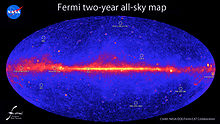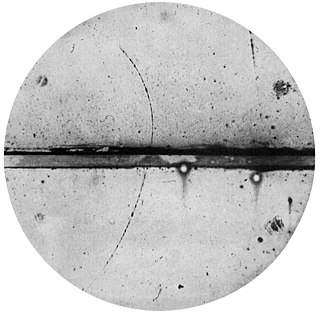
In modern physics, antimatter is defined as matter composed of the antiparticles of the corresponding particles in "ordinary" matter, and can be thought of as matter with reversed charge, parity, and time, known as CPT reversal. Antimatter occurs in natural processes like cosmic ray collisions and some types of radioactive decay, but only a tiny fraction of these have successfully been bound together in experiments to form antiatoms. Minuscule numbers of antiparticles can be generated at particle accelerators; however, total artificial production has been only a few nanograms. No macroscopic amount of antimatter has ever been assembled due to the extreme cost and difficulty of production and handling.

The positron or antielectron is the particle with an electric charge of +1 e, a spin of 1/2, and the same mass as an electron. It is the antiparticle of the electron. When a positron collides with an electron, annihilation occurs. If this collision occurs at low energies, it results in the production of two or more photons.

Cosmic rays are high-energy particles or clusters of particles that move through space at nearly the speed of light. They originate from the Sun, from outside of the Solar System in our own galaxy, and from distant galaxies. Upon impact with Earth's atmosphere, cosmic rays produce showers of secondary particles, some of which reach the surface, although the bulk is deflected off into space by the magnetosphere or the heliosphere.
The Greisen–Zatsepin–Kuzmin limit (GZK limit or GZK cutoff) is a theoretical upper limit on the energy of cosmic ray protons traveling from other galaxies through the intergalactic medium to our galaxy. The limit is 5×1019 eV (50 EeV), or about 8 joules (the energy of a proton travelling at ≈ 99.99999999999999999998% the speed of light). The limit is set by the slowing effect of interactions of the protons with the microwave background radiation over long distances (≈ 160 million light-years). The limit is at the same order of magnitude as the upper limit for energy at which cosmic rays have experimentally been detected, although indeed some detections appear to have exceeded the limit, as noted below. For example, one extreme-energy cosmic ray, the Oh-My-God Particle, which has been found to possess a record-breaking 3.12×1020 eV (50 joules) of energy (about the same as the kinetic energy of a 95 km/h baseball).

The Japanese Experiment Module (JEM), nicknamed Kibō, is a Japanese science module for the International Space Station (ISS) developed by JAXA. It is the largest single ISS module, and is attached to the Harmony module. The first two pieces of the module were launched on Space Shuttle missions STS-123 and STS-124. The third and final components were launched on STS-127.

The Fermi Gamma-ray Space Telescope, formerly called the Gamma-ray Large Area Space Telescope (GLAST), is a space observatory being used to perform gamma-ray astronomy observations from low Earth orbit. Its main instrument is the Large Area Telescope (LAT), with which astronomers mostly intend to perform an all-sky survey studying astrophysical and cosmological phenomena such as active galactic nuclei, pulsars, other high-energy sources and dark matter. Another instrument aboard Fermi, the Gamma-ray Burst Monitor, is being used to study gamma-ray bursts and solar flares.

The Japan Aerospace Exploration Agency (JAXA) is the Japanese national air and space agency. Through the merger of three previously independent organizations, JAXA was formed on 1 October 2003. JAXA is responsible for research, technology development and launch of satellites into orbit, and is involved in many more advanced missions such as asteroid exploration and possible human exploration of the Moon. Its motto is One JAXA and its corporate slogan is Explore to Realize.
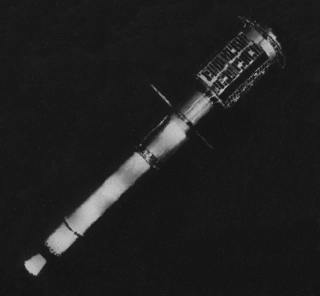
Explorer 11 was a NASA satellite that carried the first space-borne gamma-ray telescope. This marked the beginning of space gamma-ray astronomy. Launched on 27 April 1961 by a Juno II, the satellite returned data until 17 November 1961, when power supply problems ended the science mission. During the spacecraft's seven-month lifespan it detected twenty-two events from gamma-rays and approximately 22,000 events from cosmic radiation.
The Extreme Universe Space Observatory onboard Japanese Experiment Module (JEM-EUSO) is the first space mission concept devoted to the investigation of cosmic rays and neutrinos of extreme energy (E > 5×1019 eV). Using the Earth's atmosphere as a giant detector, the detection is performed by looking at the streak of fluorescence produced when such a particle interacts with the Earth's atmosphere.

PAMELA was a cosmic ray research module attached to an Earth orbiting satellite. PAMELA was launched on 15 June 2006 and was the first satellite-based experiment dedicated to the detection of cosmic rays, with a particular focus on their antimatter component, in the form of positrons and antiprotons. Other objectives included long-term monitoring of the solar modulation of cosmic rays, measurements of energetic particles from the Sun, high-energy particles in Earth's magnetosphere and Jovian electrons. It was also hoped that it may detect evidence of dark matter annihilation. PAMELA operations were terminated in 2016, as were the operations of the host-satellite Resurs-DK1. The experiment was a recognized CERN experiment (RE2B).
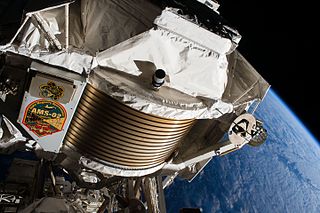
The Alpha Magnetic Spectrometer (AMS-02) is a particle physics experiment module that is mounted on the International Space Station (ISS). The experiment is a recognized CERN experiment (RE1). The module is a detector that measures antimatter in cosmic rays; this information is needed to understand the formation of the Universe and search for evidence of dark matter.

The Advanced Thin Ionization Calorimeter (ATIC) is a balloon-borne instrument flying in the stratosphere over Antarctica to measure the energy and composition of cosmic rays. ATIC was launched from McMurdo Station for the first time in December 2000 and has since completed three successful flights out of four.
The Monitor of All-sky X-ray Image (MAXI) is an X-ray telescope mounted on the International Space Station since 2009. The instrument uses wide field of view X-ray detectors to perform a sky survey, measuring the brightness of X-ray sources every 96 minutes.

The High Altitude Water Cherenkov Experiment or High Altitude Water Cherenkov Observatory is a gamma-ray and cosmic ray observatory located on the flanks of the Sierra Negra volcano in the Mexican state of Puebla at an altitude of 4100 meters, at 18°59′41″N97°18′30.6″W. HAWC is the successor to the Milagro gamma-ray observatory in New Mexico, which was also a gamma-ray observatory based around the principle of detecting gamma-rays indirectly using the water Cherenkov method.
The Dark Matter Particle Explorer, or DAMPE, also known as Wukong, is a Chinese Academy of Sciences (CAS) satellite which launched on 17 December 2015. The satellite was launched on a Long March 2D rocket from Launch Pad 603 at the LC-43 complex, also known as the South Launch Site, at the Jiuquan Satellite Launch Center. It is China's first space observatory.
The X-Ray Imaging and Spectroscopy Mission, formerly the X-ray Astronomy Recovery Mission (XARM), is an X-ray astronomy satellite of the Japan Aerospace Exploration Agency (JAXA) to provide breakthroughs in the study of structure formation of the universe, outflows from galaxy nuclei, and dark matter. As the only international X-ray observatory project of its period, XRISM will function as a next generation space telescope in the X-ray astronomy field, similar to how the James Webb Space Telescope, Fermi Space Telescope, and the Atacama Large Millimeter Array (ALMA) Observatory are placed in their respective fields. The mission is a stopgap for avoiding a potential observation period gap between X-ray telescopes of the present and those of the future. Without XRISM, a blank period in X-ray astronomy may arise in the early 2020s due to the loss of Hitomi. During its formulation, XRISM/XARM was also known as the "ASTRO-H Successor" or "ASTRO-H2".
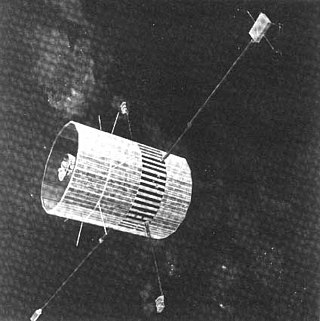
Explorer 47, was a NASA satellite launched as part of Explorer program. Explorer 47 was launched on 23 September 1972 from Cape Canaveral, Florida, with a Thor-Delta 1604. Explorer 47 was the ninth overall launch of the Interplanetary Monitoring Platform series, but received the launch designation "IMP-7" because two previous "Anchored IMP" flights had used "AIMP" instead.
Cosmic Vision is the third campaign of space science and space exploration missions in the Science Programme of the European Space Agency (ESA). Formulated in 2005 as Cosmic Vision: Space Science for Europe 2015–2025, the campaign succeeded the Horizon 2000 Plus campaign and envisioned a number of missions in the fields of astronomy and solar system exploration beyond 2015. Ten missions across four funding categories are planned to be launched under Cosmic Vision, with the first being CHEOPS in December 2019. A mission to the Galilean moons (JUICE), the first deep space mission with an opportunistic target, and one of the first gravitational-wave space observatories (LISA), are planned for launch as part of the Cosmic Vision campaign.
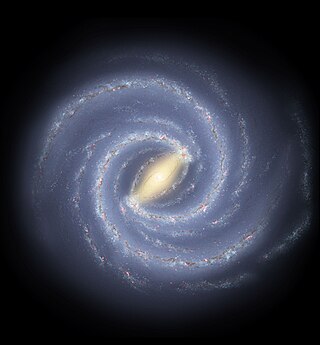
The Compton Spectrometer and Imager (COSI), is a gamma-ray telescope expected to launch in 2025 as a NASA small astrophysics mission. It is intended to study the recent history of star birth, star death, and the formation of chemical elements in the Milky Way.

